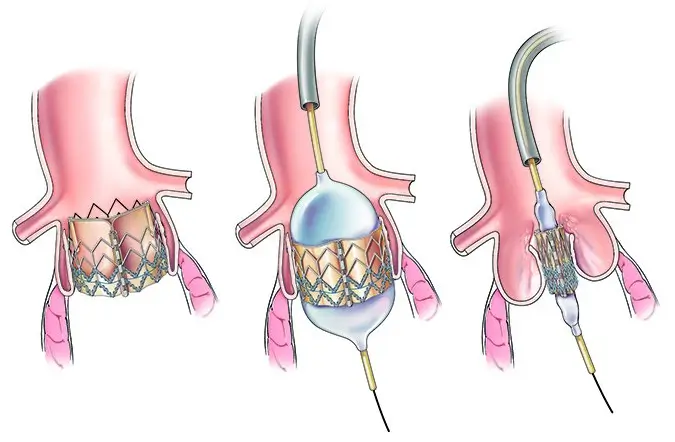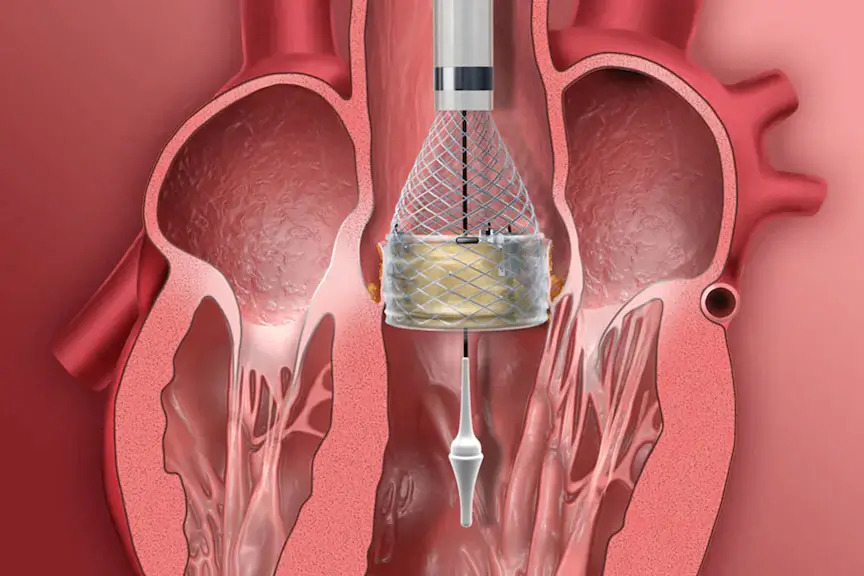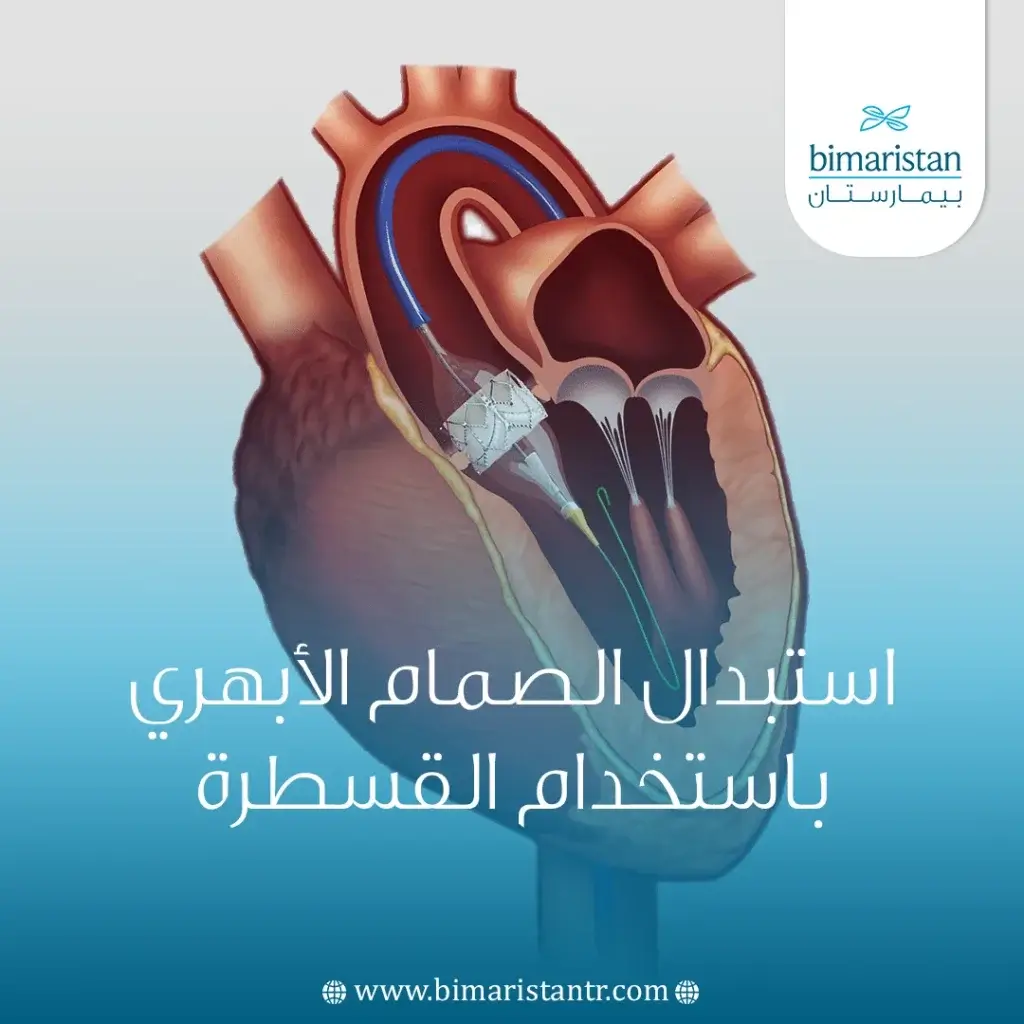عملية تغيير الصمام الاورطي بالقسطرة هي عملية طفيفة التوغل، حيث اتجه الأطباء لعملية تغيير الصمام الأبهري هذه لسهولتها وقلة مضاعفاتها في أفضل مشافي تركيا.
لنتفق أنَّ العمليات طفيفة التوغل هي التي تسود حالياً في الوسط الطبي، وهي مفضلة غالباً سواء من طرف الطبيب أو المريض، حيث أنها تقدم نفس نتائج الطرق المفتوحة بأقل الأعراض.
ولهذا نرى أنَّ تبديل الصمام الأبهري بالقسطرة هي عملية مجراة بشكل كبير في الآونة الأخيرة، ولتركيا سبق في مجال الجراحة القلبية، فتابع معنا هذا المقال الطبي لمعرفة السبب.
ما هي عملية تغيير الصمام الاورطي بالقسطرة TAVR (Transcatheter Aortic Valve Replacement)؟
إن عملية تغيير الصمام الاورطي بالقسطرة هي عملية جراحية تستهدف تغيير الصمام الأبهري لدى تخربه أو عدم قدرته على أداء وظيفته بالشكل المطلوب، وهي غالباً ما تجرى لدى مرضى تضيق الأبهر.
من خلال هذه العملية الصغيرة يتم وضع صمام القلب الجديد فوق الصمام المريض حيث يتم الحصول على صمام جدود دون إجراء عمل جراحي.
إن هذا الصمام يعمل بشكل مشابه للشبكات التي تستخدم في توسيع الأوعية (التاجية) الإكليلية عند انسدادها (بسبب احتشاء عضلة القلب).
حيث إنه بمجرد وضع صمام القلب الجديد يقوم بإبعاد الصمام القديم ليحل محله في تنظيم حركة الدم (عملية صمام داخل صمام).

ما الذي ينطوي عليه إجراء عملية تغيير الصمام الاورطي بالقسطرة TAVR؟
عادةً ما يتطلب استبدال الصمام إجراء قلب مفتوح مع “شق عظم القص”، حيث يتم فصل الصدر جراحياً (فتح) للاستبدال، بينما يمكن إجراء عملية TAVR أو TAVI من خلال فتحات صغيرة جداً تترك جميع عظام الصدر في مكانها.
بالرغم من أن لكل عملية مهما كانت صغيرة عدة مخاطر، إلى أن مخاطر هذه العملية قليلة جداً إذ تشابه وضع دعامة في الشرايين الاكليلية كما أنها توفر خياراً جيداً للمرضى الذين ليس لديهم فرصة لتغيير الصمامات عبر الجراحة، ويوجد طريقتان لهذا العملية يقوم الطبيب باختيار أفضلهما بالنسبة لحالتك:
الطريقة الأولى:
يقوم دكتور الأوعية بإدخال القسطرة القلبية من الشريان الفخذي أو الكعبري، والذي لا يتطلب شق جراحي في الصدر ويتم علاج العديد من المرضى بالأدوية المهدئة والتخدير الموضعي، التي تسمى بالأدوية المخدرة غير المنومة، ويتم الوصول للصمام بمساعدة الأشعة التداخلية ويوضع الصمام الاصطناعي مكان الصمام القديم.
الطريقة الثانية:
الإجراء الثاني يتم عن طريق الدخول بواسطة شق جراحي صغير جداً في الصدر ومن ثم يتم الوصول للصمام الأورطي.
هل عملية تغيير الصمام الاورطي بالقسطرة أفضل أم جراحة الصمام الأورطي عبر المنظار أو الروبوت؟
تمت الموافقة على هذا الإجراء مؤخرًا من قبل إدارة الغذاء والدواء الأمريكية (FDA)، وهو بديل للجراحة للمريض الذين يعاني من تضيق الصمام الأبهري في حال كانت الجراحة عالية الخطورة.
حيث يوجد هناك اختلافات كبيرة بين جراحة الصمام الأبهري القياسية وTAVI.
قد يكون TAVR أيضاً خياراً مناسباً إذا كان لديك صمام بيولوجي تم زرعه سابقاً لاستبدال الصمام الأبهري ولكنه لا يعمل الآن بشكل جيد.
يجب التنويه إلى أنَّ الصمام الأبهري ( الاورطي )الصنعي الذي يستخدم في هذه العملية قد يكون مصنوع من طيات تؤخذ من قلب الخنزير، فيجب تنويه الطبيب في حال كانت لديك مشكلة مع هذا الأمر، ليضع لك صماماً أخذت بعض مكوناته إما من البقر (وهو الغالب) أو من حيوانات أخرى حسب ما يراه الطبيب.

من هو المرشح المناسب لعملية تغيير الصمام الاورطي بالقسطرة؟
عادة ما يكون المرضى الذين يخضعون لإجراء TAVI في السبعينيات أو الثمانينيات من عمرهم، لذلك فهم يعانون من مشاكل صحية أخرى مصاحبة، وهؤلاء المرضى يستفيدون أكثر عند استخدام الطرق طفيفة التوغل ذوات التعافي السريع.
على الرغم من أنها طريقة جديدة، إلا أنها تزيد بشكل كبير من جودة الحياة في المرضى الذين يعانون من مرض الصمام الأبهري وليس لديهم بديل جراحي، وذلك أنه يمنع المزيد من الضرر للقلب ويزيد من جودة الحياة وزيادة مدة البقاء على قيد الحياة، وهو ما لا يمكن تحقيقه بالعلاج الدوائي.
كما أن نوعية الحياة – كما أوضحت الدراسات قصيرة الأمد على عملية استبدال الصمام الأبهري باستخدام القسطرة – كانت متشابهة مع العملية الجراحية، ولكن إلى الآن لا يوجد دراسات كافية حول أفضلية اختيار العلاج عن طريق القسطرة أو عن طريق الجراحة.
لكن المثبت إلى الآن عبر هذه الدراسة والعديد من الدراسات الأخرى أن تغيير صمام القلب عبر القسطرة هو المعيار الذهبي للمرضى الذين لديهم أعراض بسبب تضيق صمام الأبهر والمصنفين ضمن عاليي الخطورة من أجل إجراء تداخل جراحي.
للمعرفة أكثر عن عمليات تغيير صمامات القلب في تركيا وهل القسطرة القلبية أفضل أم جراحة القلب المفتوحة؟ يمكنك التواصل معنا، حيث يقدم لك مركز بيمارستان أفضل الاستشارات الطبية ويوجهك إلى أفضل المراكز الطبية بأقل سعر ممكن.
مضاعفات إجراء عملية تغيير الصمام الاورطي بالقسطرة وما بعد العملية
إن هذه العملية قليلة المضاعفات، إلا أن تغيير صمام مهم كالصمام الأبهري وفي موقع حساس قد يحمل بعض المخاطر منها:
- أذية في الأوعية الدموية لدى المريض
- سكتة دماغية
- قصور قلبي شديد
- تجمع السوائل في القلب
- نزيف بسبب الأدوية المميعة التي يستخدمها المريض في معظم الأحيان
- فشل كلوي بسبب الأدوية التي تعطى أثناء العملية والتي قد تسبب صدمة تحسسية (نسبتها قليلة جداً)
- عدم انتظام نبضات القلب والحاجة إلى زرع جهاز لتنظيم ضربات القلب
- نوبة قلبية
- إصابة إنتانية
جميع هذه المضاعفات نادرة نسبيا، وقد عملت تركيا على التخفيف من المضاعفات عبر تدريب أفضل الدكاترة وتجهيز المشافي لتقديم العلاج الأمثل للمرضى في تركيا.
غالباً ما يخرج المريض بعد يوم أو يومين من العملية، ويمكنه أن يمشي بشكل طبيعي فور خروجه.
وبعد العملية سيقوم الطبيب بوصف بعض الأدوية لك، ويعطيك الإرشادات الكاملة لتجنب إجهاد القلب أو الصمام الجديد في الفترة ما بعد العملية.
كما بإمكانكم قراءة المزيد حول استبدال الصمام عبر الجراحة الروبوتية في تركيا.
بالنهاية نجد أنَّ عملية استبدال الصمام الأبهري عبر القسطرة هي المفضلة لدى العديد من المرضى كبار السن، حيث شكلت أملاً كبيراً لدى هؤلاء المرضى غير المرشحين للعمل الجراحي المفتوح، وهذا ما يعمل مركز بيمارستان على تقديمه لمرضاه بمختلف أعمارهم وأحوالهم.
تكلفة عملية تغيير الصمام الأورطي
تختلف تكلفة عملية تغيير الصمام الأورطي بشكل كبير اعتمادًا على العديد من العوامل، بما في ذلك:
نوع العملية:
- عملية القلب المفتوح: تتراوح تكلفة عملية القلب المفتوح لتغيير الصمام الأورطي بين 20,000 دولار و 150,000 دولار أمريكي.
- عملية تغيير الصمام الأورطي عبر القسطرة (TAVI): تتراوح تكلفة عملية TAVI بين 30,000 دولار و 200,000 دولار أمريكي.
نوع الصمام:
- الصمامات الميكانيكية: تدوم لفترة أطول، ولكنها قد تتطلب تناول مضادات التخثر مدى الحياة.
- الصمامات البيولوجية: تتطلب استبدالها بعد 10-15 سنة، ولكنها لا تتطلب تناول مضادات التخثر.
موقع المستشفى:
- الولايات المتحدة الأمريكية: من أغلى الدول لإجراء عملية تغيير الصمام الأورطي.
- أوروبا: تكلفة العملية أقل من الولايات المتحدة الأمريكية، ولكنها لا تزال مرتفعة.
- الهند وتركيا: من الدول التي تقدم تكلفة معقولة لعملية تغيير الصمام الأورطي.
التأمين الصحي:
يمكن أن يساعد التأمين الصحي في تغطية تكلفة العملية، ولكن قد تكون هناك تكاليف إضافية غير مشمولة.
العوامل الأخرى:
- خبرة الجراح: قد يكون الجراحون ذوو الخبرة الكبيرة أكثر تكلفة.
- حالة المريض: قد تتطلب بعض الحالات رعاية صحية أكثر تكلفة.
بعض الأمثلة على تكلفة عملية تغيير الصمام الأورطي في بعض الدول:
- الولايات المتحدة الأمريكية: 50,000 – 150,000 دولار أمريكي
- ألمانيا: 30,000 – 80,000 دولار أمريكي
- الهند: 10,000 – 25,000 دولار أمريكي
- تركيا: 15,000 – 40,000 دولار أمريكي
المصادر:

